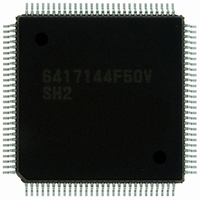HD6417144F50V Renesas Electronics America, HD6417144F50V Datasheet - Page 244

HD6417144F50V
Manufacturer Part Number
HD6417144F50V
Description
IC SUPERH MCU ROMLESS 112QFP
Manufacturer
Renesas Electronics America
Series
SuperH® SH7144r
Datasheet
1.HD64F7144F50V.pdf
(932 pages)
Specifications of HD6417144F50V
Core Processor
SH-2
Core Size
32-Bit
Speed
50MHz
Connectivity
EBI/EMI, I²C, SCI
Peripherals
DMA, POR, PWM, WDT
Number Of I /o
74
Program Memory Type
ROMless
Ram Size
8K x 8
Voltage - Supply (vcc/vdd)
3 V ~ 3.6 V
Data Converters
A/D 8x10b
Oscillator Type
Internal
Operating Temperature
-20°C ~ 75°C
Package / Case
112-QFP
For Use With
HS0005KCU11H - EMULATOR E10A-USB H8S(X),SH2(A)EDK7145 - DEV EVALUATION KIT SH7145
Lead Free Status / RoHS Status
Lead free / RoHS Compliant
Eeprom Size
-
Program Memory Size
-
Available stocks
Company
Part Number
Manufacturer
Quantity
Price
Company:
Part Number:
HD6417144F50V
Manufacturer:
Renesas Electronics America
Quantity:
10 000
- Current page: 244 of 932
- Download datasheet (6Mb)
10. Direct Memory Access Controller (DMAC)
DRAK is output once for the first DREQ sampling, irrespective of transfer mode or DREQ
detection method. In burst mode, using edge detection, DREQ is sampled for the first cycle only,
so DRAK is also output for the first cycle only. Therefore, the DREQ signal negate timing can be
ascertained, and this facilitates handshake operations of transfer requests with the DMAC.
Cycle Steal Mode Operations: In cycle steal mode, DREQ sampling timing is the same
irrespective of dual or single address mode, or whether edge or low-level DREQ detection is used.
For example, DMAC transfer begins (figure 10.14), at the earliest, three cycles from the first
sampling timing. The second sampling begins at the start of the transfer one bus cycle prior to the
start of the DMAC transfer initiated by the first sampling (i.e., from the start of the CPU(3)
transfer). At this point, if DREQ detection has not occurred, sampling is executed every cycle
thereafter.
As in figure 10.15, whatever cycle the CPU transfer cycle is, the next sampling begins from the
start of the transfer one bus cycle before the DMAC transfer begins.
Figure 10.14 shows an example of output during DACK read and figure 10.15 an example of
output during DACK write.
Figures 10.16 and 10.17 show cycle steal mode and single address mode. In this case, transfer
begins at earliest three cycles after the first DREQ sampling. The second sampling begins from the
start of the transfer one bus cycle before the start of the first DMAC transfer. In single address
mode, the DACK signal is output during the DMAC transfer period.
Burst Mode, Dual Address, and Level Detection: Figures 10.18 and 10.19 show the DREQ
sampling timing in burst mode with dual address and level detection. DREQ sampling timing in
this mode is virtually the same as that of cycle steal mode.
For example, DMAC transfer begins (figure 10.18), at the earliest, three cycles after the timing of
the first sampling. The second sampling also begins from the start of the transfer one bus cycle
before the start of the first DMAC transfer. In burst mode, as long as transfer requests are issued,
DMAC transfer continues. Therefore, the “transfer one bus cycle before the start of the DMAC
transfer” may be a DMAC transfer.
In burst mode, the DACK output period is the same as that of cycle steal mode.
Burst Mode, Single Address, and Level Detection: DREQ sampling timing in burst mode with
single address and level detection is shown in figures 10.20 and 10.21.
In burst mode with single address and level detection, a dummy cycle is inserted as one bus cycle,
at the earliest, three cycles after timing of the first sampling. Data during this period is undefined,
Rev.4.00 Mar. 27, 2008 Page 198 of 882
REJ09B0108-0400
Related parts for HD6417144F50V
Image
Part Number
Description
Manufacturer
Datasheet
Request
R

Part Number:
Description:
KIT STARTER FOR M16C/29
Manufacturer:
Renesas Electronics America
Datasheet:

Part Number:
Description:
KIT STARTER FOR R8C/2D
Manufacturer:
Renesas Electronics America
Datasheet:

Part Number:
Description:
R0K33062P STARTER KIT
Manufacturer:
Renesas Electronics America
Datasheet:

Part Number:
Description:
KIT STARTER FOR R8C/23 E8A
Manufacturer:
Renesas Electronics America
Datasheet:

Part Number:
Description:
KIT STARTER FOR R8C/25
Manufacturer:
Renesas Electronics America
Datasheet:

Part Number:
Description:
KIT STARTER H8S2456 SHARPE DSPLY
Manufacturer:
Renesas Electronics America
Datasheet:

Part Number:
Description:
KIT STARTER FOR R8C38C
Manufacturer:
Renesas Electronics America
Datasheet:

Part Number:
Description:
KIT STARTER FOR R8C35C
Manufacturer:
Renesas Electronics America
Datasheet:

Part Number:
Description:
KIT STARTER FOR R8CL3AC+LCD APPS
Manufacturer:
Renesas Electronics America
Datasheet:

Part Number:
Description:
KIT STARTER FOR RX610
Manufacturer:
Renesas Electronics America
Datasheet:

Part Number:
Description:
KIT STARTER FOR R32C/118
Manufacturer:
Renesas Electronics America
Datasheet:

Part Number:
Description:
KIT DEV RSK-R8C/26-29
Manufacturer:
Renesas Electronics America
Datasheet:

Part Number:
Description:
KIT STARTER FOR SH7124
Manufacturer:
Renesas Electronics America
Datasheet:

Part Number:
Description:
KIT STARTER FOR H8SX/1622
Manufacturer:
Renesas Electronics America
Datasheet:

Part Number:
Description:
KIT DEV FOR SH7203
Manufacturer:
Renesas Electronics America
Datasheet:











